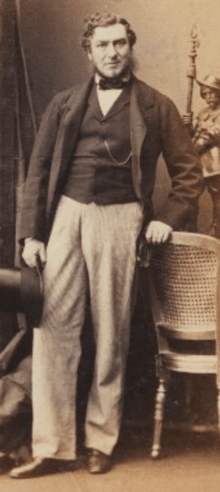Douglas Labalmondière
Lieutenant-Colonel Douglas William Parish Labalmondière CB (3 June 1815[1] – 8 March 1893) was the first Assistant Commissioner (Administrative) of the London Metropolitan Police and acted as Commissioner for three months in 1868–1869.

Labalmondière was descended from an aristocratic French family who had established sugarcane plantations in the West Indies. He was educated at Eton College and the Royal Military College, Sandhurst, where he passed out at the head of the list with exceptional honours, and was commissioned an ensign into the 83rd (County of Dublin) Regiment of Foot (later the Royal Irish Rifles). He served in the Canadas, 1837–1838, carried dispatches during Mackenzie's Rebellion and Papineau's Rebellion, and was promoted lieutenant. He was promoted captain in 1844. In 1846–1849, he served in Ireland during the Irish Potato Famine, as temporary inspector with special duties under the Poor Law Commissioners. Following closure of the local relief committees in 1847, public testimonials of his endeavours were sent by committees in Castlegregory,[2] Castleisland,[3] Ventry,[4] Tralee[5] and Ballincuslane.[6]
Following his order to rejoin his regiment in 1849 in India, he gave evidence to the Select Committee on Poor Laws (Ireland) on 20 March 1849[7] and on 23 March 1849.[8] Whilst in India with his regiment, he was appointed to the Metropolitan Police and was permitted to return overland.[9]
In 1850, he retired on half pay as a lieutenant-colonel and joined the Metropolitan Police as its second inspecting superintendent, effectively functioning as deputy to the two Joint Commissioners, Sir Richard Mayne and Captain William Hay (who had been his predecessor as inspecting superintendent). He was appointed Companion of the Order of the Bath (CB) for his services in policing the Great Exhibition in 1851 and in 1855 was selected to attend Queen Victoria in Paris.
In 1856, after Hay's death and the reorganisation of the police, Labalmondière was appointed Assistant Commissioner (Administrative). He was responsible for administration and discipline, with the Assistant Commissioner (Executive), Captain W. C. Harris, being responsible for supplies, buildings and other such business. Mayne was now the sole Commissioner. One of Labalmondière's duties was to make quarterly inspections of every police station and station house, with every tour of inspection taking nineteen days.
After Mayne's death on 26 December 1868, Labalmondière acted as Commissioner until the appointment of Colonel Edmund Henderson three months later. He continued to serve Henderson and his successor, Sir Charles Warren, as Assistant Commissioner until his retirement in 1888.
Footnotes
- Canada, British Regimental Registers of Service, 1756–1900
- Kerry Evening Post, 29 September 1847
- Kerry Evening Post, 15 September 1847
- Kerry Evening Post, 2 October 1847
- Tralee Chronicle, 2 October 1847
- Kerry Evening Post, 29 September 1847
- Third report from the Select Committee on Poor Laws (Ireland) - House of Commons
- Fourth Report from the Select Committee of the House of Lords - Operation of the Irish Poor Law - House of Commons
- London Evening Standard, 2 April 1850
References
- The Times
- Martin Fido & Keith Skinner, The Official Encyclopedia of Scotland Yard (Virgin Books, London:1999)
External links
| Police appointments | ||
|---|---|---|
| Preceded by William Hay |
Inspecting Superintendent, Metropolitan Police 1850–1856 |
Succeeded by Last incumbent |
| Preceded by First incumbent |
Assistant Commissioner (Administrative), Metropolitan Police 1856–1888 |
Succeeded by Alexander Carmichael Bruce |
| Preceded by Sir Richard Mayne |
Commissioner of Police of the Metropolis (Acting) 1868–1869 |
Succeeded by Edmund Henderson |